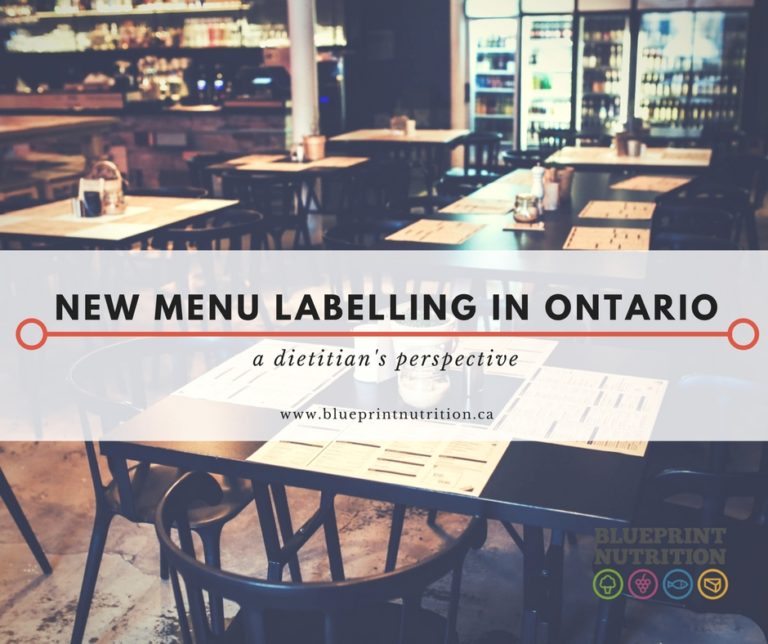There were many different topics that would have been great for my last blog post of 2016. For instance, setting New Year’s Resolutions (but I figured that’s boring and overdone), new food trends for 2017 (interesting but I try not to ride the “band wagon” on food trends all the time), and the greatest nutrition research findings for 2016 (interesting for the academics out there but likely a snooze-fest for most!) But menu labeling changes came up so it became a topic of discussion.
How did it come up?
When as I was eating out with my family the other night and saw calorie counts on the menu, that is what triggered me to remember about the big changes that are coming to menus in my lovely province of Ontario, Canada as of January 2017. I thought that this major change was worth mentioning! And why not go on another rant about food labelling changes in Canada since it has only been a week since my last one!
If you like reading laws you can check out the nitty gritty details here. If you would like the Coles Notes version, read on my friends!
Menu labeling changes 101
So, here’s the skinny. Beginning January 1st, 2017, a new regulation for menu labelling (which is part of the Healthy Menu Choices Act, 2015) will start to be enforced throughout the province of Ontario. What does this mean? To break it down simply, this law will require two things of restaurants:
- To display the number of calories for every standard food item and self-serve item, on menus (including menu boards), labels and display tags.
- To display contextual information to help educate customers about their daily caloric requirements with the following statement:
- The average adult requires approximately 2000-2400 calories per day; however, individual calorie needs may vary.
Does menu labeling changes apply to all menu items? Food and drinks?
Yes. This will apply to most foods and beverages, except any foods that are offered less than 3 months in a calendar year, self-serve condiments at the table (i.e. ketchup) and patient meals in hospitals, and long-term care homes. Even alcoholic beverages will be labelled individually or a chart will be posted with calories for a standard serving of wine, beer, etc.
Do all restaurants fall under this legislation for these menu labeling changes?
No. Only food service premises with 20 or more locations in Ontario must display the calorie content of each standard menu item. So, the stand-alone Ma and Pa Diners will not have this information available unless they have decided to provide it to keep up with their competitors.
These new rules apply to not only traditional restaurants, but also quick service restaurants, convenience stores, grocery stores, movie theatres, public-facing cafeterias, bakeries, food trucks, buffets, ice cream shops and coffee shops.

Why label calories? What’s the purpose?
The goal behind this new law is to help the people of Ontario make healthier choices when they eat out and to educate the public about the calorie content of food and beverages eaten outside of the home, which tend to be more calorie-rich than foods eaten at home.
But will the intended goal be reached?
A dietitian’s perspective – the pros and cons of menu labeling changes
The PROs:
With one in four adult Canadians and one in 10 children living with clinical obesity (= 6 MILLION Canadians living with obesity), we need to start making changes NOW! And so, I see this is a start, perhaps one small piece of the puzzle. It is my hope that listing calories on menus will at a minimum trigger people to start thinking about making changes to their diet. And hopefully there will be some evaluative processes to let us know if it is making a difference and if not, that adjustments will be made accordingly.
The CONs (just a few since you don’t have all day!)
Calories don’t paint the whole picture. Consider, for example, a salmon entrée served with brown rice and grilled vegetables in olive oil vs. a bowl of white pasta with tomato sauce. The salmon entrée may have more calories since the healthy fats from the fish and olive oil provide more calories on a per gram basis (9 calories per gram) than do carbohydrates (4 calories per gram) from the pasta. So, in this case, although the pasta may list fewer calories, I would argue that the salmon entrée is the healthier choice.
Bear in mind that the calorie content is only ever a “best guess”. It all depends on how each dish is made at the time of consumption – i.e. size of a chicken leg, the dash of oil in the pan may all vary from day to day and/or depending on which chef is in the kitchen.
I am rather disappointed about the daily caloric needs statement (the one that says thaverage adult requires 2000 – 2400 calories per day). The benchmark of 2000 calories is the same reference used on the Nutrition Facts Table on food labels and has been established within Canada and the United States as the standard reference value for food and menu labelling purposes and general nutrition advice. I thought that we are trying to get people to eat healthier and eat less, not give them the idea that they need more. This, amongst other concerns were communicated to the Honorable Dr. Eric Hoskins from Dietitians of Canada, in conjunction with other health agencies. Evidently he felt Canadians should eat more calories than we typically recommend to combat obesity.
And there simply isn’t enough time to dive into the topic of how adding calories to menus could potentially produce consequences for those struggling with eating disorders or extreme “clean eating” …
So how do you eat healthier when you eat out?

Tips for making a healthier choice when eating out, aside from looking at calories on the menu labels
Use common sense when looking at the menu – don’t just rely on the calorie counts please! Common sense (which is perhaps not so common these days) would tell us to:
- Look for menu items with whole grains, lean proteins and vegetables
- Whole grain/whole wheat pastas, wraps, pitas are all healthier options
- Choose poultry and fish options more often over red meats and processed meats
- Ideally you would like half of your plate to be covered in vegetables!
- Reduce the size of your menu selection
- Instead of ordering a double portion (i.e. double patty burger) order a single
- Choose a small (or tall) size specialty coffee drink vs. a large (or vent) size
- Share an entrée or appetizer with a friend
- Watch the extras
- Order a burger without the cheese and bacon or an egg without the sausage
- Ask for salad dressing and any condiments on the side of your dish
- Choose unsweetened coffee drinks or ask for your drink to be made “half sweet”
- Eat your calories, don’t drink them. Choose calorie-free drink options if possible.
- Water
- Sparkling water
- Unsweetened tea and coffee
The Nuts and Bolts:
Look for calorie labelling on menus of chain restaurants in Ontario with more than 20 locations starting as of January 2017. Remember to look not only at the calorie content, but also items with lots of whole grains, lean proteins, and fresh vegetables and/or fruit. If you are super keen, look at the nutritional information online prior to eating out as many list more nutrient information that may be helpful for you when choosing an item (i.e. sodium).
Take it one bite at a time,
Rosanne
If you enjoyed this article, I recommend you check out this article; Food labeling FAILURE: why the new Canadian food labels miss the mark! before you leave. It might make all the difference to what you are struggling with or the information you are looking for.
References:
Ontario Regulation 50/16 made under the Healthy Menu Choices Act 2015, S.O. 2015, c. 7, Sched. 1. Accessed December 28, 2016 here.
Canadian Obesity Network. Obesity in Canada. Accessed December 28, 2016 here.
Joint letter from Dietitians of Canada, the Ontario Public Health Association and the Ontario Society of Nutrition Professionals in Public Health to the Honorable Dr. Eric Hoskins. Accessed December 28, 2016 here.






